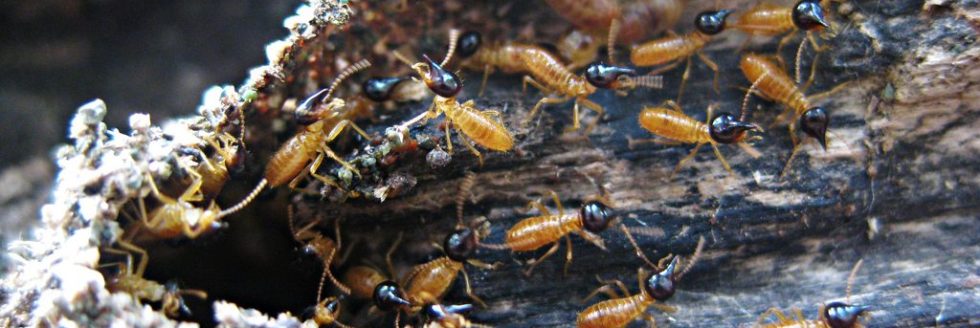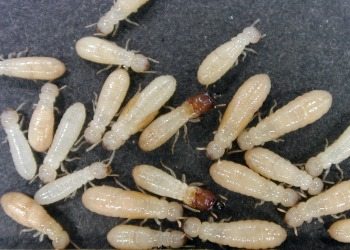North Carolina Termite Prevention Tips
Termite prevention is a serious matter for all homeowners. According to the National Pest Management Association, termites are responsible for approximately $5 billion in damage annually. Most distressingly, the cost of repairs for termite damage falls into the laps of homeowners since most insurance companies won’t provide coverage for termites. In the Carolinas, the most problematic of all types of termites is the subterranean species that typically lives underground, but will move up to the surface level as a way to wreak havoc on structures.
Termites are social insects with a king and queen residing in an underground nest. The wood-munching bugs typically make their nests near tree stumps or woodpiles to easily access a food source. A termite queen can lay thousands of eggs annually and continue to reproduce for as long as five years. Mature colonies can expand to contain anywhere from hundreds of thousands to millions of termite workers. The worker termites are responsible for colony protection and foraging for food.
The reason subterranean termites can destroy an entire home is due to their structural makeup. Termites have razor-sharp jaws and the capability of eating 24 hours a day, 7 days a week. Termites will look for food up to 200 feet away from their nesting sites. The larger termite colonies are likely to have multiple nesting sites on a single property. Unfortunately, although termites can have large colonies, the insects can easily go undetected for years. In many cases, termite damage may not even be seen until structures fail or home renovations are underway. This is the reason termite inspections are a required part of selling a home.
Termite prevention will differ from termite treatment. Termite treatment will always involve contacting a trusted pest control provider. Pest control companies help identify the species of termites and are proactive at getting rid of infestations and preventing further damage caused by termites. On the other hand, you can start a prevention program on your own which involves eliminating termite attractants around the home.

Reducing Soil Contact
Start off by inspecting around your home to check for areas where any soil and wood come into direct contact. Any type of wood material should be removed from around the foundation, including paper, plants, 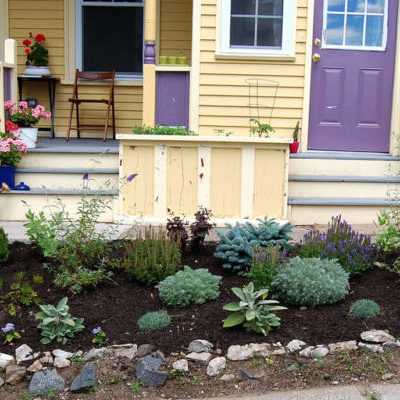 lumber and cardboard. If you have mulch outside of your home, you should have a barrier of at least four inches between the edge of the mulch and the house. During your inspection of the foundation, you must check for mud tubes. Mud tubes are created by termites from wood and soil and are used by termites to reach their food sources. The tubes are meant to protect termites and maintain the high humidity levels needed for their survival. When the tubes are broken open, you may or may not see signs of active termites. If no termites are present, it doesn’t mean your property is free of an infestation. Rather, the tubes may have simply been abandoned.
lumber and cardboard. If you have mulch outside of your home, you should have a barrier of at least four inches between the edge of the mulch and the house. During your inspection of the foundation, you must check for mud tubes. Mud tubes are created by termites from wood and soil and are used by termites to reach their food sources. The tubes are meant to protect termites and maintain the high humidity levels needed for their survival. When the tubes are broken open, you may or may not see signs of active termites. If no termites are present, it doesn’t mean your property is free of an infestation. Rather, the tubes may have simply been abandoned.
Control Drainage
Termites thrive in soil with high moisture levels. A home with poor drainage will be more prone to infestations. Divert water away from the home with the use of a French drain, sump pump or downspouts and gutters that are working properly. Remove any debris to allow water to flow freely. Installing splash blocks at the base of the downspout will push water away from the home during periods of heavy rain. Proper grading is also a must when trying to control moisture levels around the foundation of a home.
Repair Plumbing Issues
All types of plumbing leaks should be repaired immediately. Leaky faucets and pipes create excess moisture, which attracts termites. Air conditioning units must be free of leaks as well. Any type of overflow caused by air conditioners or hot water heaters must be diverted away from the property.
Control Air Moisture
Termites prefer humid conditions. Proper ventilation in basements and crawlspaces is a must. If you have issues with moisture control in these areas, products such as dehumidifiers, automatic temp vents or power vents are very useful. Also, check existing vents to confirm that they aren’t being blocked. Vents that lead to the outside 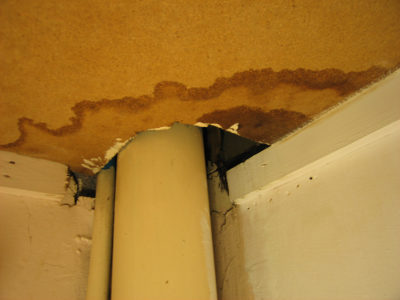 of the home can be covered with mesh to prevent termites from entering. To control moisture in crawlspaces, a vapor barrier is available for installation on the floor.
of the home can be covered with mesh to prevent termites from entering. To control moisture in crawlspaces, a vapor barrier is available for installation on the floor.
Fix Existing Damage
Any type of wood that has been damaged should be repaired immediately. This is especially important for windowsills, floor joists and wood flooring materials. While making repairs, soil should be kept at least 18 inches away from joists and 12 inches away from girders. The roof and foundation must also be inspected for damage since they contain vulnerable areas through which termites may enter. Cement can be used to repair any cracks or holes in masonry work. Repair any broken or missing roof shingles too. Keep in mind that wood shingles are prone to damage by drywood termites.
Eliminate Wood Contact
Outdoor wood structures such as decks, fences and trellises should never come into direct contact with the soil. There must be at least two inches of clearance between the soil and the wood. When installing new fence posts or constructing a new retaining wall, choose only wood that has been treated against termites.
Although it may be convenient to have firewood next to your home, this will only invite future termite infestations. Wood should be stored away from a home’s foundation and never put away in crawlspaces. At a minimum, place firewood 20 feet away from a home. Leaf piles should be kept away from the main structure of a 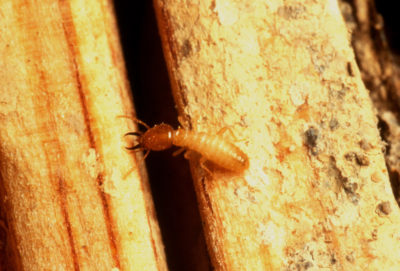 home too. Any tree stumps found on the property must be removed since they are common nesting sites for termites. Decorative wood chips near a home are also a major faux pas if you want to prevent termites. Avoid any outdoor climbing plants too since this allows for easier termite entry into the home.
home too. Any tree stumps found on the property must be removed since they are common nesting sites for termites. Decorative wood chips near a home are also a major faux pas if you want to prevent termites. Avoid any outdoor climbing plants too since this allows for easier termite entry into the home.
Check Lighting
While most termite prevention steps focus on eliminating wood and water around a home, you also must be mindful of your outdoor lighting. During swarming season after the winter frost, flying termites can and will get drawn in by outdoor lights. If possible, keep the lights off at night. Relocating any lights away from doors and windows will also prevent termites from entering the home.
Building Prevention
When a new home is being built, it is the perfect time to include products that prevent termites from infesting a structure. For instance, a basaltic termite barrier is manufactured from rock particles and is placed beneath a new building to stop subterranean termites from entering the structure. Poured concrete foundations make termites work hard to get into a home, but infestations still happen when cracks inevitably occur in the concrete and if termites find passage through holes for pipes and other features. The type of materials used in new home construction will aid in the prevention of termites. Heartwood and pressure treated wood are resistant to termites, as is steel framework.
Chemical Control
Chemical products are available to prevent termites from infesting a home. Termiticide is applied to the soil around a building and beneath the structure. The products are meant both to repel termites and create 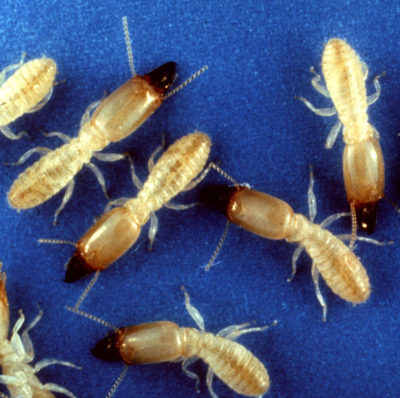 toxic conditions for the insects. Homeowners should not apply termiticides without professional assistance. Pest control companies can advise you on the advantages of specific treatments and warn of any potential negatives. They are licensed and will know which areas certain products can treat. Termite baits are also available and can be a less intrusive way to prevent and treat termite infestations. Your technician can let you know how long each treatment method will effectively protect against termites.
toxic conditions for the insects. Homeowners should not apply termiticides without professional assistance. Pest control companies can advise you on the advantages of specific treatments and warn of any potential negatives. They are licensed and will know which areas certain products can treat. Termite baits are also available and can be a less intrusive way to prevent and treat termite infestations. Your technician can let you know how long each treatment method will effectively protect against termites.
Regular Inspections
Inspections are a major part of termite prevention. Many homeowners may not feel confident enough to inspect their own properties adequately. Hiring a pest control company gives you peace of mind knowing that they are experienced in identifying the signs of termite infestations. Talk to a pest control expert about any termite signs you have noted. It is very important to monitor any skirting boards, doorframes and windows for structural changes that could be attributed to termites. Tap any wood that you suspect could be damaged. If you hear a hollow sound, termites may be the cause. Bubbling paint is another sign that termites have entered the structure. Even if you do have termite barriers installed, they must be inspected as well to ensure they have not been compromised. This is especially important after any new additions to the home have been made. For instance, putting in a new veranda or awning could make a new entryway for termites. Scaffolding should be removed immediately post-renovations too since it can be used by termites to gain building access. Request a termite inspection after home renovations to confirm that you are still well protected against invasions.
Termites don’t damage only wood in their quest for food. Termites will also eat any products that contain cellulose such as fiberboard and cardboard. While foraging for food, they could damage cables and wires inside the walls of a home. Termites have been responsible for causing major electrical issues including whole system failure. Getting a jump on termites can save you thousands and thousands of dollars.
Carolina Pest Management takes termite control very seriously. We are here to help you inspect your property and create a plan to keep your home termite free for good. If treatment is required, we use the greenest possible pest control solutions that are safe for both the environment and your family members. Maintenance after treatment is critical and our team will provide an annual inspection to check for any termite damage. Customers in the Carolinas can call today to learn more about our termite control services.

